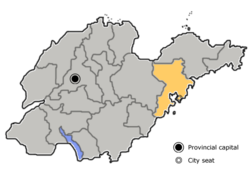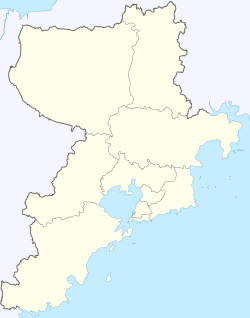
Back Qingdao Afrikaans تشينغداو Arabic تشينجداو ARZ Qingdao AST Sindao Azerbaijani Ціндаа Byelorussian Cèngto BEW Циндао Bulgarian ছিংতাও Bengali/Bangla ཆིང་ཏའོ་གྲོང་ཁྱེར། Tibetan
Qingdao
青岛市 Tsingtao | |
|---|---|
 | |
 Location of Qingdao City jurisdiction in Shandong | |
| Coordinates (Qingdao municipal government): 36°04′01″N 120°22′58″E / 36.0669°N 120.3827°E | |
| Country | China |
| Province | Shandong |
| Lease to Germany | 6 March 1898 |
| Japanese occupation | 7 November 1914 |
| Return to China | 10 December 1922 |
| Japanese Occupation | 10 January 1938 |
| Return to China | 15 August 1945 |
| Municipal seat | 11, Xianggang Middle Rd, Shinan District |
| Government | |
| • Type | Sub-provincial city |
| • Body | Qingdao Municipal People's Congress |
| • CCP Secretary | Lu Zhiyuan |
| • Congress Chairman | Wang Luming |
| • Mayor | Zhao Haozhi |
| • CPPCC Chairman | Yang Jun |
| Area | |
| 11,228.4 km2 (4,335.3 sq mi) | |
| • Land | 11,228.4 km2 (4,335.3 sq mi) |
| • Urban | 5,171.4 km2 (1,996.7 sq mi) |
| • Metro | 5,171.4 km2 (1,996.7 sq mi) |
| Population (2020 census)[1] | |
| 10,071,722 | |
| • Density | 900/km2 (2,300/sq mi) |
| • Urban | 7,172,451 |
| • Urban density | 1,400/km2 (3,600/sq mi) |
| • Metro | 7,172,451 |
| • Metro density | 1,400/km2 (3,600/sq mi) |
| GDP[2] | |
| • Prefecture-level and Sub-provincial city | CN¥ 1.200 trillion US$ 181.4 billion |
| • Per capita | CN¥ 128,459 US$ 19,412 |
| Time zone | UTC+8 (China Standard) |
| Postal code | 266000 |
| Area code | 0532 |
| ISO 3166 code | CN-SD-02 |
| License Plate Prefix | 鲁B & 鲁U |
| Coastline |
|
| Major Nationalities | Han: 99.86% |
| County-level divisions | 10 |
| Climate | Dwa/Cwa |
| Website | qingdao.gov.cn |
| Symbols | |
| Flower | China rose Camellia |
| Tree | Cedrus |
| Qingdao | |||||||||||||||||||||||||||||||||||
|---|---|---|---|---|---|---|---|---|---|---|---|---|---|---|---|---|---|---|---|---|---|---|---|---|---|---|---|---|---|---|---|---|---|---|---|
 "Qingdao" in Simplified (top) and Traditional (bottom) Chinese characters | |||||||||||||||||||||||||||||||||||
| Chinese name | |||||||||||||||||||||||||||||||||||
| Simplified Chinese | 青岛 | ||||||||||||||||||||||||||||||||||
| Traditional Chinese | 青島 | ||||||||||||||||||||||||||||||||||
| Postal | Tsingtao | ||||||||||||||||||||||||||||||||||
| Literal meaning | "Qing (color) Island" | ||||||||||||||||||||||||||||||||||
| |||||||||||||||||||||||||||||||||||
| German name | |||||||||||||||||||||||||||||||||||
| German | Tsingtau | ||||||||||||||||||||||||||||||||||
Qingdao[a] is a prefecture-level city in the eastern Shandong Province of China. Located on China's Yellow Sea coast, Qingdao was founded in 1891 to support coastal defence fortifications.[3] In 1897, the city was ceded to Germany. For the Germans Qingdao (Tsingtau) was a strategic trade center, port and base for its East Asia Squadron, allowing the German navy to project dominance in the Pacific.[4] In 1914, following the outbreak of World War I, Japan occupied the city and the surrounding province during the Siege of Tsingtao. In 1915, China agreed to recognize Japan's special position in the territory through what became known as the Twenty-One Demands.[5] In 1918, the Chinese government, under the control of the warlord Duan Qirui, secretly agreed to Japanese terms in exchange for a loan. Following the First World War, during the Paris Peace Conference, Japan secured agreements with the Allied powers to recognize its claim to the areas in Shandong, which included Qingdao, previously occupied by Germany. In 1922, Shandong reverted to Chinese control following the United States' mediation during the Washington Naval Conference.[3] Today, Qingdao is a major nodal city of the Belt and Road Initiative (BRI) that connects Continental and East Asia with Europe.[6] It has the highest GDP of any city in the province.
Administered at the sub-provincial level,[7] Qingdao has jurisdiction over seven districts and three county-level cities (Jiaozhou, Pingdu, Laixi). As of the 2020 census, Qingdao built-up (or metro) area made of the seven urban districts (Shinan, Shibei, Huangdao, Laoshan, Licang, Chengyang and Jimo) was home to 7,172,451 inhabitants, making it the 15th largest city in China by population.[8] Lying across the Shandong Peninsula and looking out to the Yellow Sea, it borders the prefecture-level cities of Yantai to the northeast, Weifang[9] to the west and Rizhao to the southwest.[10]
Qingdao is a major seaport and naval base, as well as a commercial and financial center. It is home to electronics multinationals such as Haier and Hisense. The Jiaozhou Bay Bridge, links the main urban area of Qingdao with Huangdao district, straddling the Jiaozhou Bay sea areas. Its historic German-style architecture and Tsingtao Brewery, the second largest brewery in China,[11] are legacies of the German occupation (1898–1914). Qingdao is classified as a Large-Port Metropolis.[12]
In 2007, Qingdao was named as one of China's top ten cities by the Chinese Cities Brand Value Report.[13] In 2009, Qingdao was named China's most livable city by the Chinese Institute of City Competitiveness.[14][15] In 2018, Qingdao held the Shanghai Cooperation Organisation summit.[16] In the 2024 Global Financial Centers Index, Qingdao ranked 31th.[17] In 2024, Qingdao was rated as a Beta- level global city by the Globalization and World Cities Research Network.[18]
Qingdao is also one of the world's top 50 cities for global scientific research as tracked by the Nature Index.[19] The city was also ranked 20th globally in the "Global Top 100 Science & Technology Cluster Cities" as of 2024.[20] It is home to several notable universities, including the Ocean University of China, China University of Petroleum, Shandong University of Science and Technology, Qingdao, Qingdao University of Science and Technology Qingdao University of Technology, and Qingdao Agricultural University.[21]
- ^ "China: Shāndōng (Prefectures, Cities, Districts and Counties) - Population Statistics, Charts and Map".
- ^ "Shandong Statistical Yearbook-2016". www.stats-sd.gov.cn.
- ^ a b Elleman, Bruce (2002). Wilson and China (1st ed.). Routledge. ISBN 978-0765610515.
- ^ Stephenson, Charles (2017). The Siege of Tsingdao. Pen & Sword Military.
- ^ "Shandong question | Chinese Imperialism, Nationalism & Revolution | Britannica". www.britannica.com. Retrieved 20 June 2024.
- ^ 2017中国青岛青岛概况 - 中文 - 青岛之窗 - 让青岛走向世界,让世界了解青岛. www.qingdaochina.org. Archived from the original on 6 March 2019. Retrieved 4 March 2019.
- ^ 中央机构编制委员会印发《关于副省级市若干问题的意见》的通知. 中编发[1995]5号. 豆丁网. 19 February 1995. Archived from the original on 29 May 2014. Retrieved 28 May 2014.
- ^ "China: population of major cities 2021". Statista. Retrieved 7 February 2023.
- ^ Wei fang wen hua zhi (Di 1 ban ed.). Ji nan: Qi Lu shu dian. 1997. ISBN 978-7-5333-0653-3.
- ^ "山东省" [Shandong Province]. China Oceanic Information Network. National Ocean Information Center.
- ^ "China Beer" (PDF). Archived from the original (PDF) on 4 March 2016. Retrieved 13 June 2013.
- ^ Roberts, Toby; Williams, Ian; Preston, John (2021). "The Southampton system: A new universal standard approach for port-city classification". Maritime Policy & Management. 48 (4): 530–542. doi:10.1080/03088839.2020.1802785. S2CID 225502755.
- ^ "China's Top 10 Most Livable Cities". hnloudi.gov.cn. Hunan Loudi Official Government. 28 March 2012. Archived from the original on 10 April 2013. Retrieved 18 June 2014.
- ^ "List of 10 Most Livable Cities in China Issued". 9 July 2009. Archived from the original on 26 April 2011. Retrieved 18 December 2010.
- ^ Lin Liyao (蔺丽瑶) (27 July 2011). "Top 10 livable cities in China 2011". China.org.cn. Archived from the original on 23 September 2012. Retrieved 10 September 2012.
- ^ "China Focus: What to expect from SCO summit in Qingdao". Xinhua. Archived from the original on 29 June 2018. Retrieved 29 June 2018.
- ^ "GFCI 36 Rank - Long Finance". www.longfinance.net. Retrieved 9 December 2024.
- ^ "World Cities 2024". GaWC. Retrieved 9 December 2024.
- ^ "Leading 200 science cities | Nature Index 2023 Science Cities | Supplements | Nature Index". www.nature.com. Retrieved 22 November 2023.
- ^ "Science and Technology Cluster Ranking 2024". global-innovation-index. Retrieved 29 August 2024.
- ^ "US News Best Global Universities Rankings in Qingdao". U.S. News & World Report. 26 October 2021. Retrieved 31 October 2021.
Cite error: There are <ref group=lower-alpha> tags or {{efn}} templates on this page, but the references will not show without a {{reflist|group=lower-alpha}} template or {{notelist}} template (see the help page).







